Parlez-vous agility?
 Mary
Ann Nester went to Switzerland to find out if the hills were alive with agility dogs. When
Veronica Hanmer of the Union Canine de Trelex invited her to give a week-end agility course,
she yodelled yes, yes, yes! Although she would have to leave her own dogs and husband at
home, she felt the opportunity to meet agility enthusiasts abroad was too good to be missed.
Maybe she would find a dog called 'Maria.' Mary
Ann Nester went to Switzerland to find out if the hills were alive with agility dogs. When
Veronica Hanmer of the Union Canine de Trelex invited her to give a week-end agility course,
she yodelled yes, yes, yes! Although she would have to leave her own dogs and husband at
home, she felt the opportunity to meet agility enthusiasts abroad was too good to be missed.
Maybe she would find a dog called 'Maria.'
The Union Canine de Trelex has about 150 to 200
members and runs classes in puppy socialisation, obedience and agility. It is one of
seven clubs belonging to the Association Suisse de Sports Canins which has been in
existence for about seven or eight years. Located in the Swiss Romande, everyone speaks French.
Parle-tu Français?
I was assured that communication would not be a problem. Most of the Swiss speak at
least two languages, one is usually English, and a translator would be available. Well, I
wasn't going to let my high school French go to waste. I didn't mix my rights (droite) and
lefts (gauche) too much - at least not anymore than I do in English. I did ask everyone to
point at the hurdle with their leg (jambe) when I meant arm (bras). My worst pronunciation
effort was the weave command (slalom) which came out of my mouth as the Hebrew greeting
'Shalom.' By the end of the week-end, I could act out the part of a dog or a handler so
convincingly that there was no need for speech!
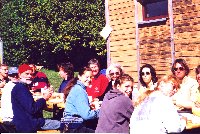 The
Venue The
Venue
The Union Canines de Trelex train outdoors spring, summer and fall - too much snow in the
winter. They could not wish for more beautiful surrounding. From the training field I
could see Mt. Blanc, Lake Geneva and a couple of cows. Car parking is not a problem where there
is so much space, but the best place to abandon your car is near the cabin and puppy pen.
The cabin is the place to go for a mid-morning break of
coffee and croissant and it is big enough to cater for dinner parties of twenty or more! It
also provides storage space for equipment. The puppy pen is enclosed by a chain linked fence
and is not far off the size of many English training halls. After puppy classes, it
serves as a parking area for dogs whose owners are otherwise occupied eating sandwiches, moving
the A-frame or working a second dog.
The Equipment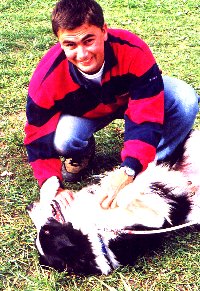
It was all good quality stuff with a Premier
flavour. But not Charlie-proof. Lindsey's collie, Charlie, managed to knock a wooden
pole flying into the air that landed on the ground
and split in half. It was quite spectacular and I was very glad not to have been standing
nearby. We all know that accidents happen in any sport and try to take appropriate steps to
ensure that they are as few as possible.
To ensure maximum safety for their dogs, the Union
Canines de Trelex needed a bulk supply of pegs. I convinced them that pegging the weave
poles to the ground would stop the wobble-effect and allow their dogs to wiggle through them
without lifting the frame into the air.
I also suggested pegging down the collapsible tunnel.
David's collie, Toby, entered this obstacle at such speed that I thought he was going to turn
it inside out. What a difference when the entrance and exit (not too tight, s'il vous plâit -
they're not all mini height!) are pegged down. When the chute is pegged, the dog has to run the
length of it, even if exiting to the left or right. It is worth pegging any
obstacle that is likely to move or be lifted off the ground.
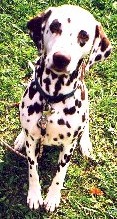 The
Maxis The
Maxis
The Agilitynet Survey 2000
revealed that the most popular breed for agility in the UK is the Collie. The number of Collies
in my Swiss maxi class was equalled or surpassed by the number of Golden Retrievers, Dalmatians
and cross breeds. I suspect many of the Union Canine de Trelex members have chosen
Goldies and Dalmatians as pets because two of the club's trainers, Veronica and Lindsey, handle
and breed that type of dog. Even I, a mini dog handler, was tempted by the Dalmatians who were
great characters and very able agility dogs.
Veronica and Lindsey explained that dogs must be licensed
in order to register their progeny with the Kennel Club. They must pass a 'beauty' test
(confirmation, colour, etc.) and temperament test. The temperament test includes an assessment
of breed characteristics: for example, Golden Retrievers must demonstrate a natural ability to
track and retrieve.
 The
Minis The
Minis
The mini dogs included two Border Terriers, a Sheltie, a Staffie and a number of X's. My
favourite was Sonny Boy, a Teckel (working Dachshund) X Papillon. I have never seen
this particular cross anywhere before and was surprised to see such a handsome dog display such
high speed and manoeuvrability. The partnership between Sonny Boy and Nadia, his fifteen year
old owner, is a joy to behold and I think they could give many in Britain a run for their
money!
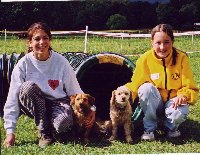 The
people The
people
The Swiss are well-known for their clean living and dour expressions. When I met the
members of the Union Canine de Trelex, I confess to being a little bit scared. They looked so
serious. Would these people ever smile? By the end of the week-end, I had succeeded in getting
everyone to loosen up. I wasn't working a dog so I cheered their successes and it caught on.
Learning to shout "Go, go, go, go, go!" was simply a case of following my example. They
applauded their team in relay races and shouted "Bravo" when a class mate's dog hit a touch
point. All except Lindsey who had to hang loose. Her Collie needed no encouragement to be
enthusiastic around the agility ring. I don't know how much agility everyone learned, but I
think they had a good time!
 Getting
to know you day Getting
to know you day
Saturday was divided into jumping exercises and weaving and contact work pitched at
a Starters/Novice level. All the dogs had some competition experience and their handlers were
open to new training ideas and methods.
We had a banquet in the evening at the clubhouse and I
gave a presentation on the English agility scene illustrated by slides taken during the
Longleat Show. I wanted to give them an idea of the sheer numbers of agility competitors going
out each and every week-end to run their dogs and get eliminated. A question and answer session
followed focusing on topics such as sponsorship, the classification system, and pre- course
nerves. It also gave people the opportunity to ask me personal questions like, 'How old is your
Miniature Poodle, Brillo?' or 'How often do you train your dogs?'
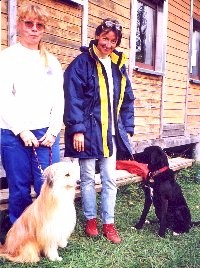 The
next day The
next day
Sunday, we returned to the agility field for further jumping exercises and contact
work - would they handle their contacts as they had described in their homework?
After a picnic lunch, I briefed them on course-walking;
for example, how to detect and avoid traps and how to negotiate start and finishing poles.
We ran a competition to put everything into practice - Minis and Maxis ran over the same course
and were placed to third. I was very impressed with everyone's performance, especially sixteen
year old Sabrina and Dolly, her Bouvier X. Dolly looked like an enlarged version of my
very first dog, Jip, and I couldn't help but have a soft spot for her. Sabrina's Dolly loves
agility and tries to always be in the right. It is very difficult to pilot a dog who is so fast
and tries to guess the handler's wishes. Although Dolly did not achieve a clear round this
time, when she does, she will be hard to beat.
Time to Go
It had only taken me the week-end to get into the habit of kissing everyone three
times in greeting. Three does seem excessive, but I'm not going to be the one to rail against
tradition. I had a wonderful time.
My advice is never pass the up an opportunity to do what
you do at home in another country. The problems of a foreign language, customs and Kennel Clubs
can all be overcome - especially when your hostess is Veronica Hanmer. A common love of
dogs doing what they love best will break down most barriers and widen your personal horizons.
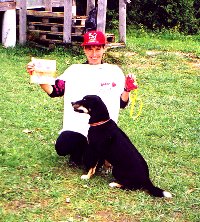 About
the author... About
the author...
Mary Ann Nester
(left)
is a member of APDT. Born in the USA, she came to Britain in
1972 as a student. She has pursued a mixed career - fruit picker, gymnastic coach, keep-fit
instructor and academic librarian. In 1997 she set up Aslan Enterprises, a dog-training school
named after her first agility dog.
Running Aslan, a lurcher dog, at agility
competitions got Mary Ann hooked on the sport and Bounty, a German Shepherd Dog, and Tam, the
Border Collie were soon added to the household.
Mary Ann's most successful dog to date has been Brillo
Pad, a Miniature Poodle who took her to Olympia and Crufts. Brillo also competed in the Draw
Challenge on National Lottery Live!, winning Mary Ann the privilege of pushing the button that
released the evening's lottery balls in front of millions of television viewers.
Daz, another miniature poodle and most recent addition,
was bought for competition in the Mini ring, but grew too tall! He has proved that size doesn't
matter. He entertained the crowds at Olympia as one of the 'fun dogs' and has strutted his stuff
in the ABC competition (Any Breed but Collie) at Crufts.
Photos: Mary Ann Nester
|